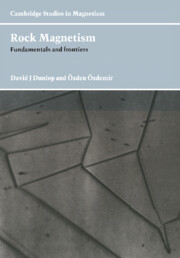Book contents
- Frontmatter
- Contents
- Preface
- Chapter 1 Magnetism in nature
- Chapter 2 Fundamentals of magnetism
- Chapter 3 Terrestrial magnetic minerals
- Chapter 4 Magnetostatic fields and energies
- Chapter 5 Elementary domain structures and hysteresis
- Chapter 6 Domain observations
- Chapter 7 Micromagnetic calculations
- Chapter 8 Single-domain thermoremanent magnetization
- Chapter 9 Multidomain thermoremanent magnetization
- Chapter 10 Viscous and thermoviscous magnetization
- Chapter 11 Isothermal magnetization and demagnetization
- Chapter 12 Pseudo-single-domain remanence
- Chapter 13 Crystallization remanent magnetization
- Chapter 14 Magnetism of igneous rocks and baked materials
- Chapter 15 Magnetism of sediments and sedimentary rocks
- Chapter 16 Magnetism of metamorphic rocks
- Chapter 17 Magnetism of extraterrestrial rocks
- References
- Index
Chapter 14 - Magnetism of igneous rocks and baked materials
Published online by Cambridge University Press: 06 July 2010
- Frontmatter
- Contents
- Preface
- Chapter 1 Magnetism in nature
- Chapter 2 Fundamentals of magnetism
- Chapter 3 Terrestrial magnetic minerals
- Chapter 4 Magnetostatic fields and energies
- Chapter 5 Elementary domain structures and hysteresis
- Chapter 6 Domain observations
- Chapter 7 Micromagnetic calculations
- Chapter 8 Single-domain thermoremanent magnetization
- Chapter 9 Multidomain thermoremanent magnetization
- Chapter 10 Viscous and thermoviscous magnetization
- Chapter 11 Isothermal magnetization and demagnetization
- Chapter 12 Pseudo-single-domain remanence
- Chapter 13 Crystallization remanent magnetization
- Chapter 14 Magnetism of igneous rocks and baked materials
- Chapter 15 Magnetism of sediments and sedimentary rocks
- Chapter 16 Magnetism of metamorphic rocks
- Chapter 17 Magnetism of extraterrestrial rocks
- References
- Index
Summary
In spite of the generality of the physical principles outlined in previous chapters, the natural remanent magnetization (NRM) of rocks is enormously variable in its intensity, its time stability and its resistance to thermal and AF demagnetization. This chapter and the two that follow will study magnetism in the context of the formation and subsequent alteration of igneous, sedimentary, and metamorphic rocks. In each case, the environment determines which magnetic minerals form, their composition and grain size, and microstructure such as exsolution intergrowths and internal stress.
The oceanic lithosphere and linear magnetic anomalies
Our treatment of igneous rocks begins with the oceanic lithosphere, the largest continuous igneous body available for paleomagnetic study. Linear anomalies in the geomagnetic field over the oceans (‘magnetic stripes’) are replicas of the regular pattern of NRM in the seafloor and provide tangible evidence of seafloor spreading (§1.2.1). In turn, it was the obvious fidelity of the seafloor paleomagnetic record that, in the minds of most earth scientists, proved the validity of the paleomagnetic method as applied to much older continental, and even extraterrestrial, rocks.
The Vine and Matthews' model
Figure 1.4 summarizes the Vine and Matthews' (1963) model. A similar interpretation of magnetic stripes was put forward about the same time by L. J. Morley (see Cox, 1973, p. 224). At a mid-ocean ridge, basaltic magma rising from shallow depths in the upper mantle is extruded as pillow lavas (seismic layer 2A, 0.5–1 km thick), intruded at shallow depths as sheeted dikes and sills (layer 2B, 1–2 km) or cools at depth as massive gabbroic plutons (layer 3, 2–5 km).
- Type
- Chapter
- Information
- Rock MagnetismFundamentals and Frontiers, pp. 391 - 424Publisher: Cambridge University PressPrint publication year: 1997
- 1
- Cited by



